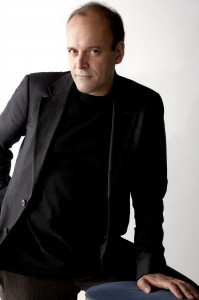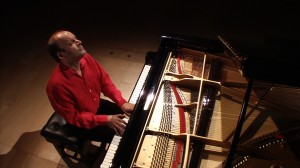Lortie’s Elegance Headlines Symphony Program
The pianist Louis Lortie headlined this week’s Jacobs Masterworks concert by the San Diego Symphony in more ways than one. Mr. Lortie not only provided the marquee performance but the work in which he was featured turned out to be the most interesting of the three on the program.
Camille Saint-Saëns wrote his Piano Concerto No. 5 in F Major, Op. 103, the Egyptian, while vacationing in Luxor, Egypt. Saint-Saëns loved to travel, and he had visited Egypt regularly, particularly after he suffered the demise of several family members. He had become enchanted with the sounds he heard on the African continent and incorporated them into more than one of his pieces. In the Egyptian concerto, Saint-Saëns wrote that he included a love song he heard sung by boatmen as they transported him up the Nile River.
But, the name, Egyptian, seems only a stand-in for Saint-Saëns’ love of travel and exotic lands. It is, in many ways, a joyful piece, employing a pastiche of different-sounding melodic and harmonic devices within a very traditional structure. Saint-Saëns was a virtuoso pianist, and though the rarely-performed Concerto No. 5 requires great skill its pleasures may be derived from the devices themselves rather than from the soloist’s pyrotechnics.
 Mr. Lortie, a specialist in French piano literature, played elegantly and with great precision. The score calls for closer collaboration between soloist and orchestra than is evident in many concerti, and conductor Jahja Ling and the members of the San Diego Symphony proved to be excellent collaborators. Piano and orchestra surged nicely in exchanging lead and accompanying duties in the middle Andante movement (which turned out not to be as Andante as one might have expected) and in the concluding Molto Allegro movement (which, likewise, defied expectations, concluding the work not with a stream of glory but with a quiet, meditative, and utterly heart-wrenching piano solo).
Mr. Lortie, a specialist in French piano literature, played elegantly and with great precision. The score calls for closer collaboration between soloist and orchestra than is evident in many concerti, and conductor Jahja Ling and the members of the San Diego Symphony proved to be excellent collaborators. Piano and orchestra surged nicely in exchanging lead and accompanying duties in the middle Andante movement (which turned out not to be as Andante as one might have expected) and in the concluding Molto Allegro movement (which, likewise, defied expectations, concluding the work not with a stream of glory but with a quiet, meditative, and utterly heart-wrenching piano solo).
After intermission, Maestro Ling and the San Diego Symphony essayed another romantic work from the same period, the Symphony No. 1 in E minor, Op. 39, by Jean Sibelius. While Saint-Saëns was a prodigy and composed from a very early age, Sibelius saved his First Symphony until he was 33 and already established as a composer in his native Finland. The symphony apparently served a dual purpose. It allowed Sibelius to bring together in more developed form the nationalistic themes for which he had become renown in works such as Finlandia, and also to serve as a calling card for achieving greater recognition in European music circles.
The First Symphony seems to provide snapshots of Finnish culture, a culture that was under pressure from its neighbors, Sweden and Russia, at the time it was composed. The piece alternates among brooding melancholia, sober echoes of impending danger, and triumphant glee. It cleaves stubbornly to the conventions of European romanticism, even at a time when those conventions were evolving.
Under Mr. Ling’s leadership the works first two movements were propelled principally by solo work. In particular, Sheryl Renk’s lengthy clarinet solo that opened the first movement provided a stunning statement of its theme, and solos by cellist Yao Zhao and bassoonist Valentin Martchev were also notable. The ensemble playing felt languished, however, until dual harpists propelled the beat forward (an unusual occurrence, in my experience) toward the end of the movement. Once the Scherzo arrived, however, the mood lightened and the emotional character of the piece began to become evident. This emotionality built through the final movement until the piece concluded in an entirely satisfying manner.
The program opened with Maurice Ravel’s poème choréographique, La valse. The placement of this piece resulted from a decision not to perform Sibelius’ “March” from Karelia Suite, Op. 11, as previously announced, and the subsequent shuffling of the order of the program. La valse is certainly an odd way of opening a program that otherwise contained traditional romantic music. It comes from a period some twenty years after the other two pieces, and it represents one way in which romanticism evolved in those twenty years. It seems far better suited to close the program (which was its previous placement) than to open it.
Highly impressionistic, La valse hovers over a scene like a soaring eagle, picking up snippets of gaiety and merriment, before swooping down to enjoy the energy of the waltzes being performed in all their glory. The result can be cacophonous but with enough finesse and sensitivity can effect a turn toward high entertainment. Mr. Ling’s interpretation settled for cacophony, and probably the less said about it the better.
This program repeats Saturday, November 15, at 8pm and Sunday, November 16, at 2pm at the Jacobs Music Center’s Copley Symphony Hall.



